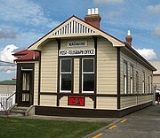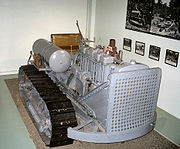
Matakohe
Encyclopedia
Matakohe is a settlement in Northland, New Zealand
. The Matakohe River is a short river which runs from the north into the Arapaoa River
, which is part of the Kaipara Harbour
. State Highway 12 passes through Matakohe. Ruawai
is 16 km to the west, and Paparoa
is 6 km north east. The Hukatere Peninsula extends south into the Kaipara Harbour.
The Kauri Museum
at Matakohe shows the area's heritage in the kauri
timber industry.
The current population is approximately 400.

 The Matakohe block was first settled by Pakeha in 1863, when members of the Albertland
The Matakohe block was first settled by Pakeha in 1863, when members of the Albertland
religious group arrived in New Zealand. The land was initially burnt off to allow for the planting of crops and grass. A weekly (initially monthly) ferry service brought mail, and a road was constructed to Paparoa. In 1881, the longest wharf in the Kaipara—1450 feet (442 m) long—was built at Matakohe to accommodate the steamers. Minnie Casey served Matakohe in the 1880s, and the S.S. Ethel, then the S.S. Tangihua in the 1890s.
The kauri gum industry
became established around Matakohe in 1867-70, possibly the first place in the Kaipara District that the industry developed amongst settlers. A flax
mill was built in 1870, but it was not profitable and was soon converted to a timber mill. This was replaced by a larger timber mill in the 1880s. The mill was destroyed by fire in 1906. Matakohe held a race-day each February, in which were entries from as far as Kaiwaka
and Waipu
.
In the 1890s, the population of Matakohe increased from 93 to 231, and the town was described as "the principal place in the Otamatea County". By 1902 the town had two boarding houses, a library, stores and a goods shed, as well as the older church and school. The population reached 264 in 1906, but declined to 141 in 1921.
Focus shifted to dairy farming in the early 20th century. Apple growing was also successful at first, but ceased by 1935 due to the Great Depression
and poor management. The roads improved, and by 1920 all 53 miles (85.3 km) of roads in the area were metalled
, using the abundant local supplies of limestone. The route to Dargaville was improved by the opening of a road through Ruawai in 1927, replacing the inland road.
of 5 and a roll of 84. The school celebrated its 125th reunion in 2003. When it was founded, the school shared a half day with Omaru School. Over the years, it has amalgamated with Ararua, Hukatere, Oparakau and Parahi schools.
There was a Matakohe School established in 1870. It used a church ante-room at first, then moved to the main church building while the school building was being constructed.
New Zealand
New Zealand is an island country in the south-western Pacific Ocean comprising two main landmasses and numerous smaller islands. The country is situated some east of Australia across the Tasman Sea, and roughly south of the Pacific island nations of New Caledonia, Fiji, and Tonga...
. The Matakohe River is a short river which runs from the north into the Arapaoa River
Arapaoa River
The Arapaoa River is a northeastern arm of the Kaipara Harbour in Northland, New Zealand. Officially designated as a river, it is some 17 kilometres in length and an average of three kilometres in width.-References:* - Search for Place Names...
, which is part of the Kaipara Harbour
Kaipara Harbour
Kaipara Harbour is a large enclosed harbour estuary complex on the north western side of the North Island of New Zealand. The northern part of the harbour is administered by the Kaipara District and the southern part is administered by the Rodney District...
. State Highway 12 passes through Matakohe. Ruawai
Ruawai
Ruawai is a small township located 30 km south of Dargaville in Northland, New Zealand. The population was 426 in the 2006 Census, a decrease of 30 from 2001....
is 16 km to the west, and Paparoa
Paparoa
Paparoa is a settlement in Northland, New Zealand. The Paparoa Stream flows from the east, through the settlement, and into the Paparoa Creek to the south, which joins the Arapaoa River which is part of the Kaipara Harbour. State Highway 12 passes through Paparoa...
is 6 km north east. The Hukatere Peninsula extends south into the Kaipara Harbour.
The Kauri Museum
Kauri Museum
The Kauri Museum is in the west coast village of Matakohe, Northland, New Zealand.The museum, to the south of the Waipoua Forest, contains many exhibits that tell the story of the pioneering days when early European settlers in the area extracted kauri timber and kauri gum.The museum has over 4000...
at Matakohe shows the area's heritage in the kauri
Agathis australis
Agathis australis, commonly known as the kauri, is a coniferous tree found north of 38°S in the northern districts of New Zealand's North Island. It is the largest but not tallest species of tree in New Zealand, standing up to 50 m tall in the emergent layer above the forest's main canopy. The...
timber industry.
The current population is approximately 400.
History


Albertland
Albertland is an area north of Auckland, New Zealand five miles North of Wellsford and site of the last organised immigration from Britain.-Immigration plans:...
religious group arrived in New Zealand. The land was initially burnt off to allow for the planting of crops and grass. A weekly (initially monthly) ferry service brought mail, and a road was constructed to Paparoa. In 1881, the longest wharf in the Kaipara—1450 feet (442 m) long—was built at Matakohe to accommodate the steamers. Minnie Casey served Matakohe in the 1880s, and the S.S. Ethel, then the S.S. Tangihua in the 1890s.
The kauri gum industry
Gum-digger
Kauri gum, a fossilized resin detracted from kauri trees, is used for chewing or tattooing, and often is made into jewellery. The gum comes from kauri trees found in Agathis australis forests. The trees once covered much of the New Zealand North Island, before Māori and European settlers caused...
became established around Matakohe in 1867-70, possibly the first place in the Kaipara District that the industry developed amongst settlers. A flax
New Zealand flax
New Zealand flax describes common New Zealand perennial plants Phormium tenax and Phormium cookianum, known by the Māori names harakeke and wharariki respectively...
mill was built in 1870, but it was not profitable and was soon converted to a timber mill. This was replaced by a larger timber mill in the 1880s. The mill was destroyed by fire in 1906. Matakohe held a race-day each February, in which were entries from as far as Kaiwaka
Kaiwaka
Kaiwaka "the little town of lights" is a settlement in Northland, New Zealand. The Kaiwaka River runs from the east through the area and joins with the Wairau River to form the Otamatea River, which drains into the Kaipara Harbour. State Highway 1 passes through Kaiwaka...
and Waipu
Waipu
Waipu is a small town in Bream Bay, in the Northland Region of New Zealand, with a Scottish heritage. The population was 1,491 in the 2006 Census, an increase of 222 from 2001. A highlight of the town's calendar is the annual Highland Games held at New Year...
.
In the 1890s, the population of Matakohe increased from 93 to 231, and the town was described as "the principal place in the Otamatea County". By 1902 the town had two boarding houses, a library, stores and a goods shed, as well as the older church and school. The population reached 264 in 1906, but declined to 141 in 1921.
Focus shifted to dairy farming in the early 20th century. Apple growing was also successful at first, but ceased by 1935 due to the Great Depression
Great Depression
The Great Depression was a severe worldwide economic depression in the decade preceding World War II. The timing of the Great Depression varied across nations, but in most countries it started in about 1929 and lasted until the late 1930s or early 1940s...
and poor management. The roads improved, and by 1920 all 53 miles (85.3 km) of roads in the area were metalled
Metal (pavement)
The term road metal refers to the crushed rock used for road beds, surfaces, 'all-weather' walkways and paths, foundations, and railway embankments, among other things. The use of road metal dates back to antiquity.-History:...
, using the abundant local supplies of limestone. The route to Dargaville was improved by the opening of a road through Ruawai in 1927, replacing the inland road.
Notable people
- Gordon CoatesGordon CoatesJoseph Gordon Coates, MC and bar served as the 21st Prime Minister of New Zealand from 1925 to 1928.- Early life :Born on the Hukatere Peninsula in Kaipara Harbour where his family ran a farm, Coates took on significant responsibility at a relatively early age because his father suffered from...
, Prime Minister 1925-28, born on the Hukatere Peninsula, and attended Matakohe School.
Education
Matakohe School is a coeducational full primary (years 1-8) school with a decile ratingSocio-Economic Decile
Decile, Socio-Economic Decile or Socio-Economic Decile Band is a widely used measure in education in New Zealand used to target funding and support to more needy schools....
of 5 and a roll of 84. The school celebrated its 125th reunion in 2003. When it was founded, the school shared a half day with Omaru School. Over the years, it has amalgamated with Ararua, Hukatere, Oparakau and Parahi schools.
There was a Matakohe School established in 1870. It used a church ante-room at first, then moved to the main church building while the school building was being constructed.

